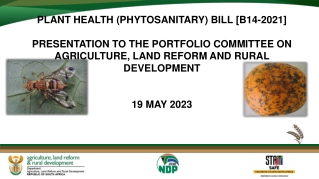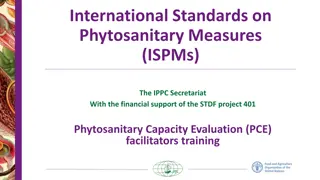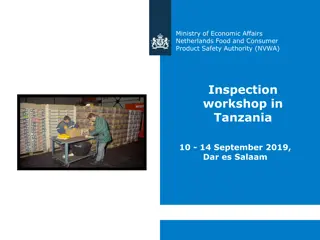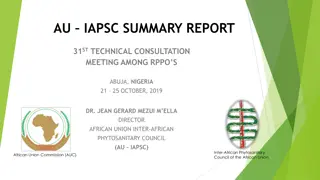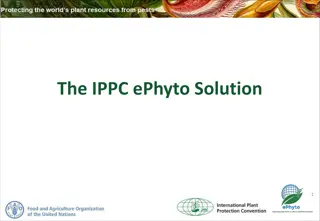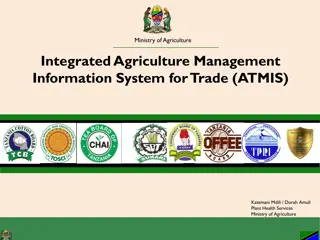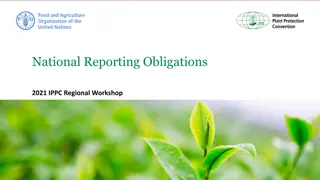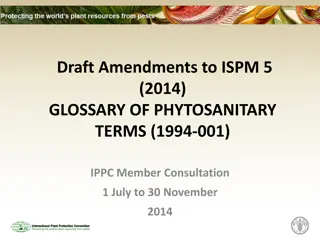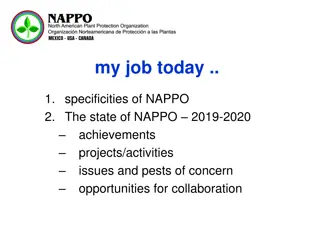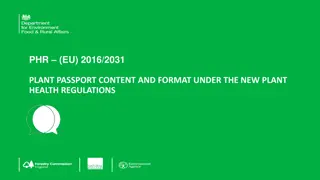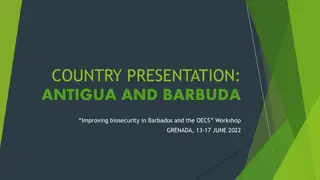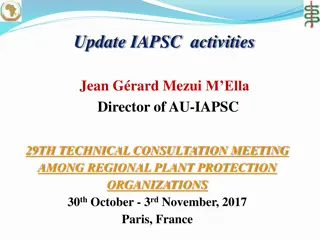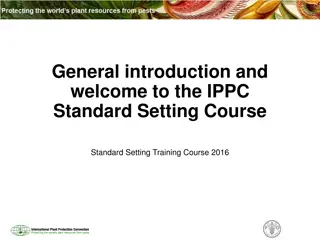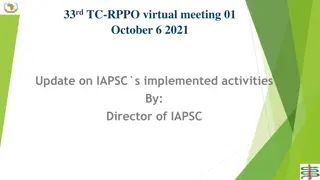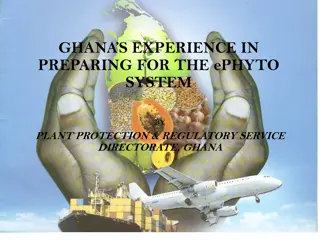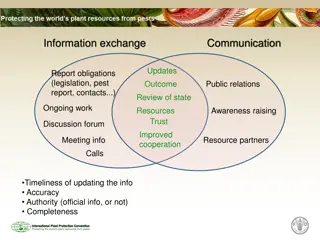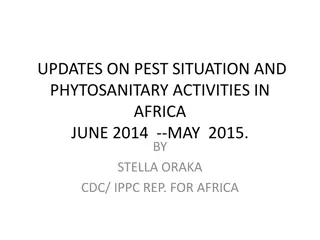PHYTOSANITARY REPORT
This report discusses the emerging issues related to phytosanitary practices in the cultivation of vegetables and flowers. The Working Group meeting held on January 28, 2017, delved into crucial topics concerning plant health and safety standards within the agricultural sector. Insights and recommendations provided in this report aim to enhance the understanding and implementation of effective phytosanitary measures.
Download Presentation

Please find below an Image/Link to download the presentation.
The content on the website is provided AS IS for your information and personal use only. It may not be sold, licensed, or shared on other websites without obtaining consent from the author.If you encounter any issues during the download, it is possible that the publisher has removed the file from their server.
You are allowed to download the files provided on this website for personal or commercial use, subject to the condition that they are used lawfully. All files are the property of their respective owners.
The content on the website is provided AS IS for your information and personal use only. It may not be sold, licensed, or shared on other websites without obtaining consent from the author.
E N D
Presentation Transcript
PHYTOSANITARYREPORT Vegetable/Flower Emerging Issues Working Group January 28, 2017
Topics/Issues to Cover USDA APHIS Initiatives: NSHAPP, ReFreSH Seed ISPM: Expectations for 2017, ISF proposed activities Country issues: Chile, Brazil
ReFreSH ReFreSH = Regulatory Framework for Seed Health New APHIS initiative that will focus on regulating seed via recognition of seed quality management practices that reduce/manage phytosanitary risk rather than regulating each consignment/shipment Foundation of program will be accreditation of seed companies based on their seed QM practices and their overall capacity to manage phytosanitary risk The new seed ISPM, once adopted, will provide an overall framework for this approach
A Complicated Trade Model 3 1 5 2 6 4 7 1.Breeding parental lines: Europe State 1 2.Production of basic seeds: Europe State 2 3. Treatment and manufacture of basic seeds: Europe state 1 4. Production of hybrid seeds: China 5. Treatment and manufacture of commercial seeds: Europe state 1 6. Commercial packaging: USA 7. Final market: Mexico *Adapted from a presentation by Ric Dunkle, PPQ Seed Summit, 2014
Export Trends More concern about seed as a pathway More testing before shipment and upon arrival Mother plant testing replacing field walks Interest in developing accreditation systems 6
Challenges of Seed Trade Seed potential pathway for pathogens Visual inspection not effective at finding pathogens Seed moves in complex global patterns NPPOs are all coming up with disparate solutions to the seed problem
Potential Models Considered NAPPRA and NSHAPP Citrus Nursery Stock Protocol EC Nursery Passport Seed Industry Best Management Practices ISPM 15 SANC USGCP/USNCP
Commonalities of Systems Considered Start clean and stay clean Document systems to maintain integrity of crop Using testing to verify system integrity Complicated movement patterns
International Interest in Seeds Recent increase in number of requirements and regulations from other countries Ongoing work to develop an international seed movement standard Seed treatment project in NAPPO Opportunity for PPQ and Seed Industry
A New Approach Regulatory Framework for Seed Health (ReFreSH) Risk-, science-based systems approach Work within current seed trade model Leverage industry best practices Promote global adoption of seed trade framework
ReFreSH-Clean Seed Passport Participating company will be issued a clean seed document Production process will be certified/accredited at each stage Industry required to report pests Goal: Facilitate safer global movement of clean seed
Certification/Accreditation Process Molecular Tests Field Walks Inspection Phytosanitary Certificate Issued Supporting Documentation Application
ReFreSH Test to verify and/or inspect mother plants Identify priority commodity/pest combinations Clean Source Material Safeguard and inspect/test progeny Focus on safeguarding because testing not practical Breeder Lines Use clean production practices Develop system that can be used in various locations Grow Out
ReFreSH Field inspection, test Best management practices Increase Seed Maintain identity Safeguard against pest incursions Harvest Seed Maintain identity Safeguard against pest incursions Post- harvest
Information Needs Seed production practices Global production areas and typical movement patterns Pests of high concern Differences between small and large producers 17
Information Sharing Between APHIS and Industry How can industry be comfortable sharing information? Confidentiality agreements? One on one meetings? 18
RiskCharacterization Pathway analysis Pest risk assessment of high profile crops Determine critical quarantine pests that follow the pathway
Technical Needs Develop validated testing methods for pathogens of concern Resolve sampling question What do we do with small lots of seeds? 20
Accreditation Standards Document and evaluate production practices Evaluate current best management practices What can we build on? Identify key risk management points in production and post-harvest processing Develop standards for production and post- harvest processing and storage 21
Leading a Global Conversation APHIS is working with other NPPOs to establish widely accepted global seed movement system that promotes a managed risk approach APHIS has had initial conversations with QUADs countries and Netherlands Initial discussions for an international NPPO meeting this year on seeds
Encouraging Industry Participation High industry participation key to success What can we do to encourage industry to participate? 24
Many Pieces of the Puzzle Globally. Seed industry (ASTA, NSAs, SAA, ISF) Other seed accreditation/certification systems and organizations (GSPP, NAKT, NSHS, ISHI-Veg, etc.) Other governments/NPPOs NAPPO, EPPO, IPPC
Benefits of a Seed Health Framework More predictable, technically justified requirements Faster and easier movement of seeds Lower risk of seed transmitted disease
Next Steps A joint APHIS-ASTA committee is being established to develop the concept and program: ASTA/Industry: Scott Heuchelin, Laurel Carter, Samantha Thomas, Ric Dunkle/Kelly Crist, Eric Nelson, Brad Peters, Claudia Nari, Tom Moore, Tom Day, Marel Langrens, Lisa Baker, Wayne Wiebe, Tracy Bruns, Nikki Phillips APHIS: Angela McMellen-Brannigan, Bob Bishop, Christina Devorsak, Matt Messenger, Sarika Negi, Don Seaver, Indira Singh,, Shalaja Rabindran
Next Steps Develop concept document Seek wider support within seed industry (ASTA, SAA, ISF) Validate Gottwald risk characterization model Develop international pilot program (APHIS)
Seed ISPM Status: went out for round 2 of country consultation last July1-Sept 30; Steward (Nikko Horn, Netherlands PPO) revised the standard; Standards Committee met last November and decided to move the revised standard forward to the next CPM (12) for adoption CPM 12 meets in Incheon, Republic of Korea April 4-11, 2017 Countries will have a 1 year period to prepare to implement Next steps: develop instructional materials, organize international training sessions
Seed ISPM ISF plans: Develop a manual based on the seed ISPM Organize a thematic day to be held in Budapest May 25, right after the ISF congress Tom Moore (U.S. member of the ISF Phytosanitary Committee) will be involved! Dennis Johnson is now the steward of the ISF Phytosanitary Committee (replaced Radha) ASTA plans: Support ISF activities Technical sessions: SAA, NAPPO, COSAVE
Country Issues Chile: SAG accepted all our proposals except one: CGMMV SAG will still require certification based on inspection and sampling of asymptomatic plants OR a seed test SAG indicated that it will accept a technical justification to discontinue sampling/testing of asymptomatic plants if one can be found Brazil: New Normative 16 to enter into force Feb 27; MAPA received additional analyses provided by ASTA and still analyzing/considering this info Just published a new norm for regulation of seed for research purposes (NI 52); we are analyzing and intend to provide APHIS and MAPA comments Still trying to organize a meeting with MAPA before NI 16 enters into force


